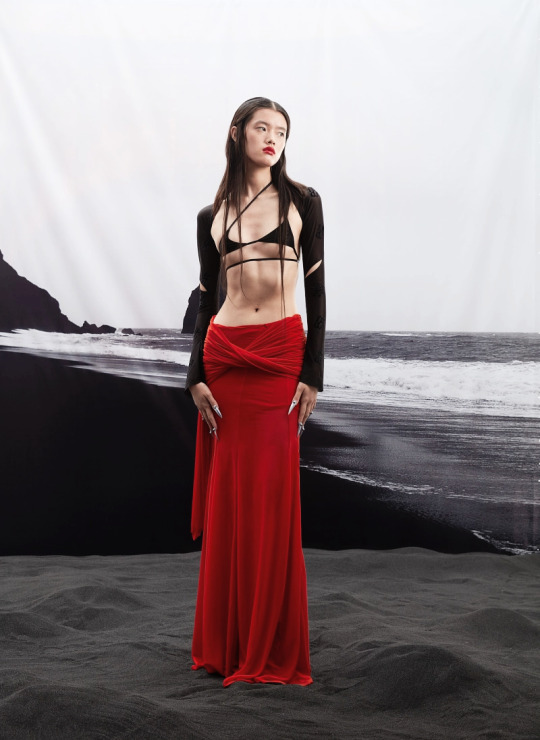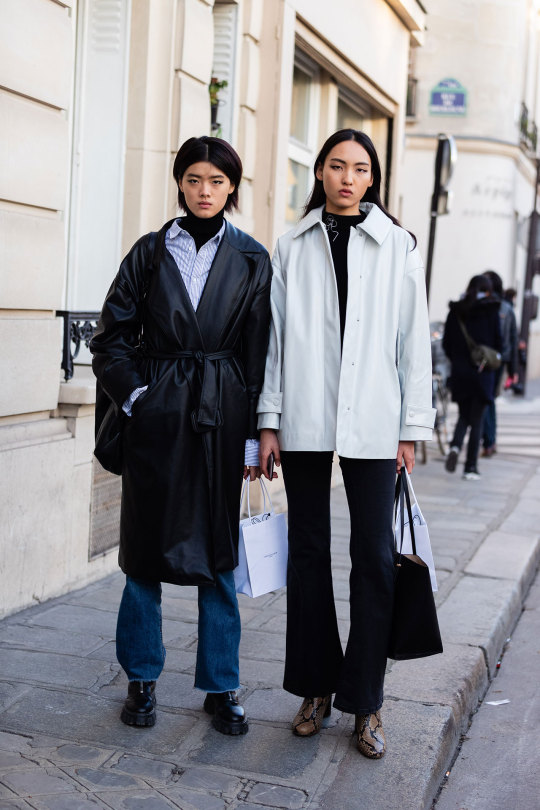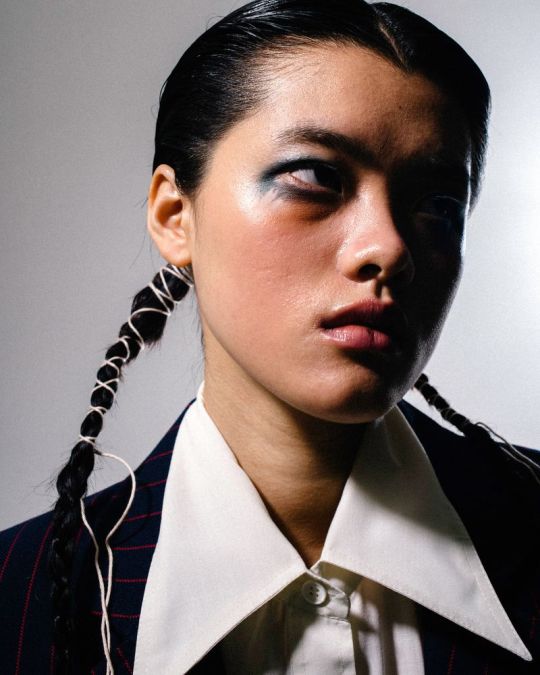#Mu Xiangyue
Text

Mu Xiangyue for DIDU Fall 2022
25 notes
·
View notes
Photo

66 notes
·
View notes
Text





Mu Xiangyue By Eva Wang For Schön Magazine March 2020. Hair By Yumiko Hikage. Makeup By Lisa Michalik.
439 notes
·
View notes
Text
Traditional Chinese Art
China, a nation of long history with profound culture, inherited and developed a great variety of traditional art forms which suit both refined and popular tastes. From the melodious and pleasant folk music to the elaborate and touching local dramas, from the simple but elegant inkwash painting to the flexible and powerful calligraphy, one can always discern the light of sparkling wisdom. Traditional Chinese arts have tremendously impressed the world.
Folk Music
Chinese folk music, with strong nationalistic features, is a treasure of Chinese culture.
As early as in the primitive times, Chinese people began to use musical instruments, which evolved today into four main types categorized by the way they are played. The first type is wind instrument, as shown in xiao (a vertical bamboo flute), flute, suo-na horn, etc. The second type is string instrument, represented by urheen, jinghu (a two-string musical instrument similar to urheen), banhu fiddle, etc. The third type is also string instrument, but played unconventionally by striking the strings with fingers, represented by guzheng (a Chinese zither with 25 strings), guqin, pipa (a plucked string musical instrument), etc. The fourth type is percussion instrument, as seen usually in gong, drum, etc.
For centuries,Chinese musicians have created numerous excellent songs and lyrics, but, unfortunately, many were lost. The extant melodies include “The Ambush on All Sides”, “Spring Snow”, “Hundred Birds Worshipping the Phoenix”, “Guangling Verse”, “Three Variations on Plum Blossom”, “Spring River Moon Night”, “The Moon Reflected on the Erquan Spring”, “Rain Pattering at Plantain Leaves”, “Higher Step by Step”, “A Thunder in the Dry Season”, etc. Those well-known melodies are often performed at home and abroad, and some have won international awards. “Hundred Birds Worshipping the Phoenix”, for example, won the second prize in the folk music contest, at the Fourth World Youth Festival.
Chinese people love folk music for its unique charm. In China, almost every region has its own folk music troupes, some of which are self-organized by folk music fans. Chinese folk music troupes are often invited to perform internationally. In recent years, they have been invited to visit Vienna-the world music capital, and perform in the famous Golden Hall during the Chinese Spring Festival. The pleasant melodies not only impress the local audiences, but also win international popularity.
Beijing Opera
Beijing Opera is the most popular and influential opera in China with a history of almost 200 years. In the course of its formation, it assimilated the best form many other local operas and was affected by Beijing local dialect and customs. Though Beijing Opera exclusive to Beijing only. Beijing opera troupes can be found in most regions of China.
Beijing Opera combines singing, recital, acting and acrobatic fighting. Singing refers to the singing according to certain tunes. Recital refers to monologues by performers and dialogues between performers. Acting refers to body movements and facial expressions. Acrobatic fighting refers to choreographed martial art.
In the long term of development, Beijing Opera has formed a number of fictitious props. For instance, a pedal means a boat, a whip in the hand means riding on a horse. Without any physical props involved, an actor may perform going upstairs or downstairs, opening or closing a door by mere gestures. Though rather exaggerated, those actions would, with their graceful movements, give audience a deep impression.
There are four main roles in Beijing Opera: sheng, dan, jing and chou. Sheng are the leading male actors, and are divided into laosheng who wear beards and represent old men, xiaosheng who represent young men, and wusheng who are acrobats playing military men and fighters. These roles usually wear no facial paintings. Famous actors playing this type of role include Ma Lianliang, Zhou Xinfang, Ye Shenglan, Gai Jiaotian and Li Shaochun. Dan are female roles. Formerly, the term meant female impersonators. It is further divided into several categories. The most important category, qingyi, usually play respectable and decent ladies in elegant costumes. Huadan represent lively and clever young girls, usually play military or non-military women capable of martial arts. Laodan are teh old ladies. Mei Lanfang, Cheng Yanqiu, Shang Xiaoyun and Xun Huisheng were the celebrated Four Major Dan Roles in the 1920s. Jing, mostly male, are the face-painted roles who represent warriors, heroes, statesmen, adventures and demons. Famous actors playing this role include Qiu Shengrong and Yuan Shihai. Chou, most of time, play roles of wit, alert and humor. It is these roles who keep the audience laughing and improvise quips at the right moments to ease tension in some serious plays. Renowned actors playing this role included Xiao Changhua and Ma Fulu.
Facial makeup in Beijing Opera has its own pattern. A sheng or a dan has to have his or her eyebrows painted in a way that they look slanted with the outer ends of eyebrows going upward, and their eyes circled with black color. As for a jing and chou, the pattern is in accordance with the disposition of the characters according to the rule of facial makeup in Beijing Opera. For example, a red face usually depicts the role’s loyalty and bravery; while a white face symbolizes a sinister role’s treachery and guile.
It is said that the complete Beijing Opera repertoire includes more than 3800 plays. What are staged today are primarily three types, newly composed historical ones and modern ones.
Beijing Opera, as the national opera, enjoys a high reputation both inside and outside China. Many foreigners have come to China to learn Beijing Opera, while many Beijing Opera troupes and famous opera actors and actresses have frequently been invited to perform abroad and have been highly appreciated by foreign audiences.
Local Opera
China is a country with vast land and various nationalities. People in different regions speak different dialects. As a result, many local opera forms have appeared alongside Beijing Opera.
Statistics show that there are more than 360 types of local operas, of which the best-known are Pingju Opera, Yue or Shaoxing Opera, Yu or Henan Opera, Huan mei Opera, Guangdong Opera, and Sichuan Opera; etc.
Pingju Opera originated in Tangshan city, Hebei Province and is popular in Beijing, Tianjin, North and Northeast of China. Pingju Opera is lively, free in style and close to life. It is a perfect form to reflect the modern life. The best-known performers include Xiao Bai Yushuang and Xin Fengxia. The representative plays are Qin Xianglian, Small Son-in-Law and Liu Qiao er, etc.
Yue or Shaoxing Opera originated in SHaoxing of Zhejiang Province and is popular in Zhejiang, Jiangsu, Jiangxi, Anhui provinces and Shanghai. At first, all of the performers ere male. But since the 1930s, all the roles were played by female performers. The tunes of this opera are mild and roundabout, and the acting is meticulous. It became the second largest opera form next to Beijing Opera. Renowned performers include Yuan Xuefen, Wang Wenjuan and Xu Yulan. The representative plays are Butterfly Lovers (or Liang Shanbo and Zhu Yingtai), A Dream of Red Mansions, etc.
Yu or Henan Opera is the local opera of Henan Province and prevalent in Henan and neighboring areas. Yu Opera is played with a bright, loud sound, alternating with sorrowful tone. There are about 650 traditional plays, of which Hua Mulan, Mu Guiying Takes Command, A Petty Official, etc. are the most famous. Well-known performers include Chang Xiangyu, Ma Jinfeng and Niu Decao.
Huangmei Opera is the local opera of Anhui Province and is popular in Anhui and Jianxi provinces, and part to Hubei Province. This opera is characterized by dancing while singing. Its tunes are mild and pleasant, and its movements and natural and graceful. It is also very close to real life. Renowned performers include Yan Fengying and Ma Lan. The representative plays are Marrying a Fairy, Emperor’s Female Son-in-Law, The Cowherd and the Girl Weaver, etc.
Guangdong Opera is the local opera form of Guangdong Province and is also popular in Guangxi Province and southern Fujian Province. Overseas Chinese in Southeast Asia, America, Europe and Oceania, and the people of Hong Kong and Mcao SARs are also very fond of this type of local opera. Guangdong Opera is sung with the Cantonese dialect and is rather unique in its singing style. The best-known performers include Hong Xiannü and Ma Shizeng. The representative plays are Searching the Study,Guan Hanqing, etc.
Quyi (Folk Art)
Quyi is a general term for all kinds of talking and singing arts. It derived from oral literature, the talking and singing performances of ancient people. It refers primarily to storytelling accentuated by body movements to tell stories, express feelings and reflect the social conditions.
There are still about 300 types of quyi beijig performed in China, including comic dialogue, dagu, kuaiban, errenzhuan, tanci, shuang-huang. Of these, the most popular is comic dialogue.
Comic dialogue is a kind of folk art with the “comic” dialogue as the main form of ancient folk jokes. Comic dialogue of today originated in Beijing and Tianjin over a century ago.
Comic dialogue realizes its artistic presentation by means of talking, imitating, teasing and singing. The jokes are skillfully hidden in the baofu, or “package”, a jargon used by the comic dialogue performers. When the right time comes. they are suddenly spilled out, just like the funny stuffs being tossed out of a carefully wrapped package, so unexpectedly, but logically with a second thought, causing the audiences to laugh.
Most of the comic dialogue stories come from daily life. Others are based on folk jokes,historic legends, events, and word games. The stage props is quite simple, a table, a fan , or a handkerchief will be adequate. It could be performed either by one person or two, or even by a group. However, normally, a comic dialogue is performed by two people. The usual pattern is that one is a straight man that asks questions and the other gives funny answers.
The best-known comic dialogue performers are Ma Sanli, Hou Baoli, Ma Ji, Jiang Kun, etc.
With the concerted effort of performers generation after generation, comic dialogue has become a national entertainment loved by highbrows and lowbrows alike.
The Game of Go
The game of go, originated in China, is the earliest form of chess in the world.
The board of go consists of a grid 19 by 19 resulting in, 361 intersections. The pieces are placed on the intersections in such a way as to gradually command more territory by surrounding and eliminating the opposition. Each of the two sides, one with black pieces and the other with white pieces, possesses 180 of them. It is an exciting and intense competition and the situation on the board keeps changing and unpredictable. Players have to resort to all sorts of tactics in order to defeat the opponent. As the tactics used in the go are so variable and profound, the ancient Chinese said in an only deities can invent such a game.
Playing go exercises the brain and enhances one’s sense of logic. At the same time, it can also cultivate temperament, build up character of perseverance and calmness. Therefore, go has become more and more popular with young people.
Go was introduced into Japan during the Sui (581-618) and Tang (618-907) dynasties and into Europe in the 19th century. Today, it has spread to more than 40 countries and regions. Players from China, Japan and The Republic of Korea are of the highest skill in the world, and Chinese competitors like Nie Weiping and Ma Xiaochun enjoy international fame. Go has been developed into a very important international contest.
The Chinese Chess
The Chinese chess, originated from the Warring States Period, is a game created on teh basis of two confronting military formations of that period. By the time of the Tang Dynasty (618-907), it had already become very popular, with its style of play basically fixed by the Song Dynasty (960-1279).
The chessboard is square in shape, with a border called the Chuhe River in the middle that separates the two sides. On either side, vertical and horizontal lines are drawn forming 90 intersections, where pieces are placed. There are altogether 32 pieces, which are divided into two groups. Characters engraved in chessmen are painted red or black respectively to represent the two sides. Each side has a Marshal (King), two Elephants, two Horses, two Chariots, two Cannons and five Soldiers, each with its designated move. At the start of play, all the chessmen must be placed in fixed positions. The red side moves first, then the players take alternate turns. Different pieces have different rules to move, for example, the Horse moves one point orthogonally followed by one point outward-diagonally, the Elephant moves exactly two points diagonally, the Chariot moves any number of points either horizontally or vertically but not diagonally, etc. When the Marshal is checked and there is no way to save him, that side is lost, but sometimes there can be a stalemate.
Since 1949, Chinese chess has been listed as an event in the national sport games. In the 1970s, Chinese chess players began to promote the game abroad, Today, more than 40 countries and regions have established their own Chinese chess clubs.
Chinese Characters
The Chinese characters constitute one of mankind’s oldest systems of writing, and have the most users in the world. There are numerous Chinese characters, totaling about 60000, with about 6000 basic ones. Chinese characters have a long history. It derived from the pictorial recording of events, known as hieroglyph. The earliest Chinese characters discovered up to now are jiaguwen (ancient Chinese characters inscribed on tortoise shells or animal bones), dating back 3400 years, which were already mature characters.
Chinese characters have undergone tremendous changes over the ages. From the earliest form of hieroglyph to the more advanced symbol character compised of strokes, it has experienced a process of jiaguwen, jinwen (ancient language used in inscriptions on ancient bronze objects), lishu (official script), and kaishu (regular script).
There are mainly four ways of creating a word as follows:
Hieroglyph refers to the method by drawing the profile of the involved subject, such as 月 which looks like a curve moon.
Self-explanatory characters are made up by adding self-explan-atory symbols on pictographs, or totally made up of symbols,such as 刃 (blade), which is made up by adding a point on the cutting edge of a knife, pointing out the position of the blade.
Associative compounds are combination of two or more symbols to represent a new character with a new meaning. For instance, the character 明(bright) is composed by 日(sun) and 月(moon). Definitely, it will be bright when the sun and the moon appear in the same place.
Pictophonetic method is a word-formation method combining one element of a character indicating meaning and the other, pronunciation, into a new word. Form element indicates the word’s meaning and characteristic. Phonetic element indicates the pronunciation of the word. For example, 湖(lake) is composed of three dots indicating water, and 胡 indicating the pronunciation.
For thousands of years, Chinese people had been writing in Complex Chinese Characters (Traditional Chinese). However, the Complex Chinese Characters are difficult to identify, memorize and write due to their complicated strokes. From 1949, for the sake of the popularization of education, the Chinese government simplified the Chinese Characters on a large scale. There were more than 2000 Complex Chinese Characters that were simplified to today’s appearance. Nowadays the Simplified Chinese Character is one of the official characters used by the UN.
In history, Chinese characters were borrowed by Korea, Japan and Vietnam for a long time. It has been borne out that Chinese characters are of vigorous vitality.
Calligraphy
Calligraphy is the traditional art of writing Chinese characters. After centuries of creation and evolution, calligraphy has become a unique from of art.
Chinese scripts are generally divided into five categories: the seal script (zhuang), the official script (li), the regular script (kai), the cursive hand (cao) and the running hand (xing). The seal script was the representative script of the Qin Dynasty (221BC-206BC). The official script was popularly used in the Han Dynasty (206BC-220AD). The regular script was the result of development of the official script. The cursive hand is a fast way of writing the regular and official scripts. The running hand is the script between the regular and cursive. Neither as neat as the former nor as difficult to recognize as the latter, it is the most commonly used, and is the easiest way of handwriting.
There have been many famous calligraphers, such as Wang Xizhi, Quyuan Xun, Yan Zhenqing, Liu Gongquan and Zhao Mengfu, to name but a few. Each, after years of hard practice, has formed a unique calligraphic style, elevating the Chinese calligraphy into a higher level.
Chinese brush, ink stick, paper and ink stone are the necessary tools and materials for writing and painting and have always been named collectively as the “Four Treasures of the Study”. To learn calligraphy, one first has to learn how to use a Chinese brush. Beginners should should start by copying the regular script.
More:
Wang Xizhi (303-361 or 321-379) was a famous calligrapher of the Eastern Jin Dynasty and enjoyed the reputation of “the saint of calligraphy”.
Ouyang Xun (557-641), with personal name as Xinben, was a famous calligrapher of the Tang Dynasty, called “the regular script top one of the Tang Dynasty”.
Yan Zhenqing (709-785), with the personal name as Qingchen, was a famous calligrapher of the Tang Dynasty. He totally got rid of the early Tang Dynasty writing style and created a new Calligraphy style.
Liu Gongquan (778-865), with the personal name of Chengxuan, was a famous calligrapher of the Tang Dynasty. He was famous for his unique script equally with Yan Zhenqing and they were called “Yan & Liu”.
Zhao Mengfu (1254-1322), with the personal name of Songxue or Oubo, was a famous calligrapher and painter of the Yuan Dynasty.
Seal Cutting
Seal cutting refers to the art of carving on a block of certain material following a diagram of calligraphy or painting already drawn on it. A unique form of traditional art in China, it is of both practical and appreciative functions.
A block thus carved is called a seal. Characters can be carved in relief or deep into the carving material. The latter is called intaglio.
At the very beginning, a seal was only used as a token of pledge or a symbol of power. It was not until the Tang Dynasty (618-907) that the seal was gradually transformed form a practical item into a piece of art. Seal cutting, as a new form of art, started in the Song (960-1279) and Yuan (1206-1368) dynasties and flourished in the late Ming Dynasty (1368-1644) and early Qing Dynasty (1644-1911). During this period, many carving artists and schools appeared. The renowned carving artists included Wen Peng, He Zhen, Ding Jing, Deng Shiru and Qi Baishi.
In seal cutting, seal style cutting is commonly used. Besides that, regular, official, running styles can also be seen. The seal itself can be made of crustal, jade, metal, animal horn, ivory, bamboo, wood, stone, etc. Stone is most extensively used, among which, Qingtian, Shousahn, Changhua and Balin seal stones are the most favorable.
In China, seal cutting is recognized by all circles and is popular today among young people.
Traditional Chinese Painting
Traditional Chinese painting is the art of painting on a piece of Xuan paper or silk with a Chinese brush that was soaked with black ink or colored pigments. It is regarded as one of the “three quintessence of Chinese culture”, the other two being traditional Chinese medicine and Beijing Opera.
By subject, traditional Chinese painting can be classified into three types, figure painting, landscape painting, and flowers and birds painting. Figure painting came into maturity as early as the Warring States Period (475-221) and reached its peak during the Tang Dynasty (618-907). Famous figure painting artists include Gu Kaizhi and Wu Daozi.
Landscape painting, as the name indicates, delineates the outside scenery. It first appeared in the Qin Dynasty (221 BC-206 BC) and became an independent genre during the Sui (581-618) and Tang dynasties. By the time of the Song Dynasty (960-1279), it had reached a very high level. Representative artists of landscape painting include Li Sixun, Fan Kuan and Tang Yin.
Flowers and birds painting concentrates on the drawing of flowers, birds, animals, fishes, and insects, etc. in their natural state. It came into being in the Northern and Southern dynasties (420-589) and became a mature art during the Song Dynasty. Celebrated artists include Zhu Da, who excelled in execution of flowers and birds, zheng Xie, who was good at bamboo, and Qi Baishi, who excelled in fish and shrimp.
By styles of brushwork,traditional Chinese painting can be categorized into “gongbi” (realistic painting characterized by fine brushwork and close attention to details) and “xieyi” (freehand brushwork aimed at catching the spirit of the object and expressing the author’s impression or mood). Unlike Western sketches which focus on truthful regeneration of subject, traditional Chinese panting pays more attention to verve and artistic conception, canonizing the idea that painting should contain more meaning than what it depicts. For instance, when Xu Beihong began to draw horses, he would firstly have shape features in his mind, and then draw a painting of horses that were more beautiful and real than horses in real life in the simple brushwork. To take “xieyi” painter Qi Baishi as another example, in one of his paintings there were two chickens scrabbling for an earthworm. However, he named the painting “Say ‘Hello’ Afterwards”, meaning that although the bubs were not so sensitive that both of them scrabble for the same food, they would have deep friendly feelings and say “Hello” to each other afterwards. The whole personification of little chickens reflected Qi’s comprehension of the whole life. In general, the style of traditional Chinese paintings is grandiose, containing ruggedness as well as detail and magnificence. In addition, its contents are rich with colorful forms.
In a finished works of traditional Chinese painting, inscriptions, poems, and stamos often come side by side. Therefore, traditional Chinese painting is an art form combining poetry, calligraphy, painting and seal carving, Its artistic achievement and national features have won recognition of the people all over the world. Thus, traditional Chinese painting brings decorous sentiment and artistic enjoyment for people.
23 notes
·
View notes